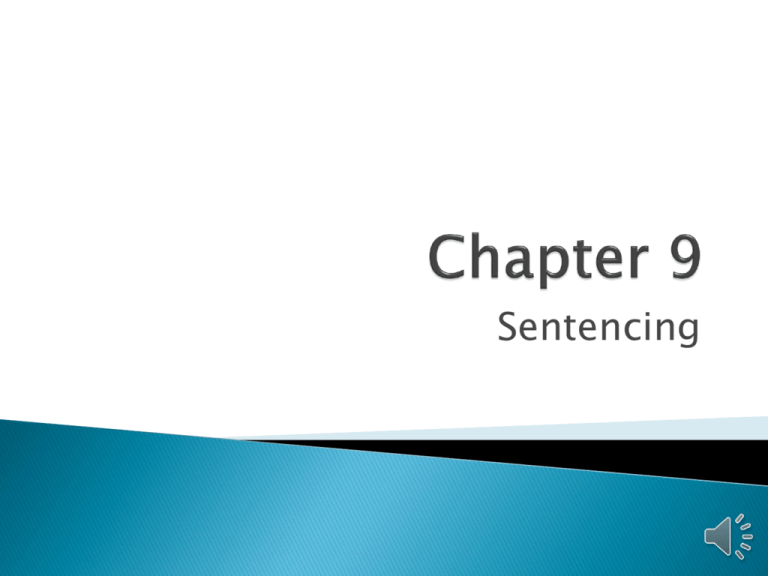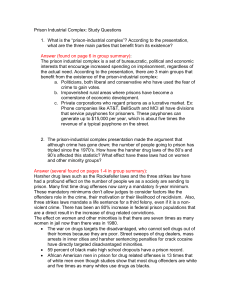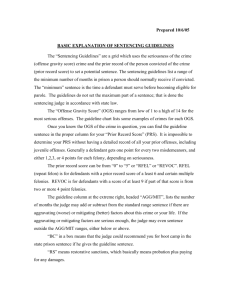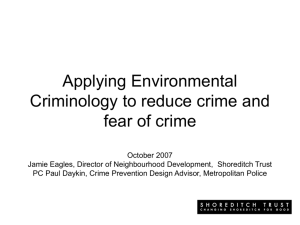CRIM3350 Lecture Nine
advertisement

Sentencing Sentencing options have traditionally included imprisonment, fines, probation, and death. These options are usually in a state's penal code and are developed by the states legislators. Around the time of the American Revolution offenders came to be seen as highly rational beings that chose their own course of action. Early sentencing philosophies stressed the need for sanctions that outweighed the benefits to be derived from criminal activity. Even though fines are used quite often in the sentencing process it does suffer from built in inequities and a widespread failure to collect them. Traditional Fines- most common punishment, is it fair to poor offenders? Day Fines- proportional fine. Fees- example, probation and prison fees Forfeiture ◦ Civil- targets property, do not require criminal proceedings. ◦ Criminal- targets people, follows a criminal conviction Fines can deprive offenders of the proceeds of criminal activity. Fines Promote rehabilitation by forcing economic responsible. Fines can be collected and are relatively inexpensive to administer. Fines can be made proportion to the severity of the offense and the offenders ability to pay. Four types of sentences can be identified ◦ Indeterminate sentencing Judge has authority to set the sentence Parole board decides release date ◦ Determinate sentencing Judge hands down fixed sentence that can’t be altered by the parole board ◦ Mandatory sentencing (ex. three strikes laws) Takes discretion from judge and parole board ◦ Sentence enhancements Increases one’s prison term because of certain circumstances and according to law Selective incapacitation (targets repeat offenders) ◦ Like preventive detention, tough to predict ◦ Goal-Keep criminals off the streets Involuntary civil commitment ◦ Mostly for sex offenders, some drug addicts ◦ Double jeopardy concerns- treatment and confinement after serving jail sentence. Some people think that longer prison terms will lead to less crime ◦ Evidence is mixed Different types of criminals Aberrations- one time offenders Low-rate offenders who eventually stop due to aging Low-rate offenders who never stop due to aging Serious offenders who eventually stop Serious offenders who never stop Offenders who will commit more and more crime over time and eventually stop ◦ Offenders who will commit more and more crime over time and never stop ◦ ◦ ◦ ◦ ◦ ◦ Conventional thinking leads us to believe that increased incarceration will reduce crime What if the opposite is true? How could it be so? Six reasons why incarceration may increase crime ◦ Shared information in prison-learn to be better offender? ◦ Frustrations from being in close quarters with others ◦ Violent experiences brought back to the community upon release ◦ Unpleasant prison experience enrages offenders- blames society for incarceration. ◦ Stigmatizing effect of prison- trans back to society hard ◦ Families deprived of primary breadwinner Determinate sentencing consists of sentencing offenders to prison for a fixed period of time with no parole, basically abolishes parole. Why determinate sentencing? ◦ Stems from a belief that parole boards have too much discretion There are several types of determinate sentencing laws ◦ Some provide time off for good behavior ◦ Judges’ discretion restricted in various ways Have determinate sentencing laws (DSLs) led to an increase in the number of people incarcerated? ◦ Six studies show increases ◦ Five show no increase or decreases What can we conclude? ◦ No one knows for sure whether DSLs have increased or decreased prison populations Do DSLs affect crime? ◦ One study (apparently the only study) found basically no effect of such laws on crime Sentence enhancement laws provide for longer prison terms for ◦ Specific offenses (example, crimes committed with guns). ◦ Crimes committed with specific motivations (hate crimes). Two varieties of sentence enhancement laws have received most of the attention ◦ Enhancements for crimes committed with drugs ◦ Enhancements for hate-motivated offenses Firearms sentence enhancement (FSE) laws mandate minimum sentence or an extra prison term for various types of gun violence FSE laws are not gun control and are viewed favorably by the pro-gun lobby The assumption is that FSE laws have a deterrent effect At least one person has challenged this argument ◦ Robberies with guns are more lucrative than robberies committed without guns, so more robberies could result if offenders fear FSE laws ◦ Robbers may commit more homicides to avoid apprehension If FSE laws don’t have a deterrent effect, they may reduce crime through incapacitation Is an “incapacitative” effect on crime possible? ◦ Some say no because Laws must result in apprehension, prosecution, conviction, and sentencing of criminals Researchers have looked at the effects of individual FSE laws on crime Several studies of laws in MA and Arizona show reductions in crime The problem? ◦ Difficult to isolate the effect of the laws vis-à-vis overall declines in gun violence during the same period Multisite Research ◦ Researchers have also compared crime rates in FSE and non-FSE states ◦ Two studies show no effect of such laws on crime Is a structured sentencing scheme that mandates clearly enumerated punishments for specific offenses or for habitual offenders convicted of serious crimes An example of mandatory sentencing schemes are the three strikes laws which require that offender serving life imprisonment without possibility of parole if convicted of a third serious felony. California's three strikes law required that three time felony offenders serve a minimum of 25 years in prison. Not all states with three strikes laws are exactly the same. Most of the controversy surrounding mandatory sentences for drug offenders stems from the Federal Sentencing Guidelines The Guidelines have been criticized because ◦ Potential for racially disparate sentencing outcomes (studies show race does influence sentencing) What about effects on crime? ◦ Little research is available State of Washington was the first to pass a threestrikes law Other states quickly followed Three-strikes laws vary considerably from state to state California’s is most controversial ◦ Passed by initiative ◦ Any third felony provides for life in prison ◦ Also contains a two-strikes provision Is three-strikes intended to deter? ◦ Some say yes ◦ Others say no because of how few offenders are sentenced under three-strikes Who cares? ◦ If three-strikes isn’t intended to act as a general deterrent, then its effects on crime will be difficult to detect Crime policies are not applied equally all of the time, in all places, to all offenders It is therefore necessary to examine the frequency with which laws are applied Who cares? ◦ If three-strikes laws aren’t applied frequently, then they won’t reduce crime Supporters of three-strikes argue that such laws ◦ Lock away serious criminals ◦ Deter additional crimes ◦ Reduce crime because of the crime declines of the 1990s that coincided with the passage of three-strikes laws Critics feel that three-strikes ◦ Can only have a specific deterrent effect ◦ Is quite costly Researchers have looked at ◦ Effects of three-strikes on the administration of justice ◦ Effects of three-strikes on crime Our concern is of course with their effect on crime What does the research show? ◦ With a few exceptions, almost all the studies show No reductions in crime (with a couple exceptions) Increases in homicide Many states today have statutory provisions that provide for a sentence of capital punishment for serious crimes. It has been estimated that 18,800 legal executions have been carried out in United States since 1608. Today the federal government and 37 of the 50 states permit execution for first-degree murder, while treason, kidnapping, aggravated rape, murder of a police or correctional officer, and murder under a life sentence are punishable by death in selected jurisdictions. In 2007 a total of 3,228 offenders were under a death sentence in United States. We can debate the death penalty on several grounds ◦ ◦ ◦ ◦ Constitutional Moral Discriminatory Deterrent Our concern is with deterrence, or, “does it work?” Almost every developed nation has done away with the death penalty Why does it persist? ◦ Zimring says its our vigilante values Capital punishment clearly works as a specific deterrent (subject cannot reoffend once they are dead). What about a general deterrent? ◦ Ehrlich found a deterrent effect (one execution deterred 8 murders) ◦ Two subsequent studies lent some support ◦ But many studies show no deterrent effect Some researchers have shown a brutalization effect resulting from capital punishment ◦ More murders following a publicized execution (gives impression government tolerates killing) Chemical castration has become a fairly popular way of dealing with sex offenders Surgical castration is less popular California appears to be the only state with a law providing for chemical castration of sex offenders Features of the law ◦ Aimed at protecting victims under the age of 13 ◦ Provides that first-time offenders may undergo castration at the discretion of the court ◦ Second-time offenders must undergo castration upon release from prison Does chemical castration work? ◦ Yes, especially when coupled with counseling Possible downsides? ◦ Need to ensure drugs are taken ◦ May have harmful effects on the body (blocks testosterone production) Sentencing- conclusions









